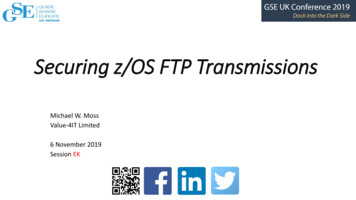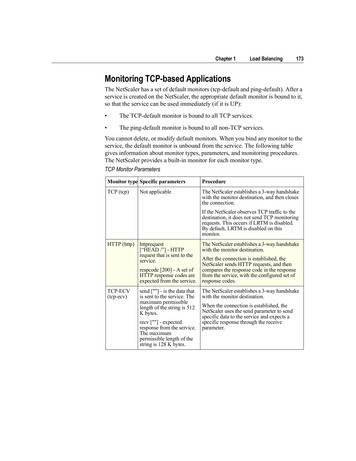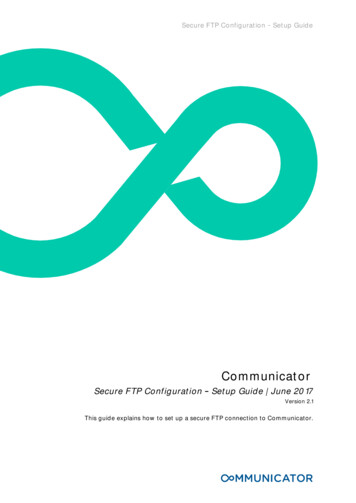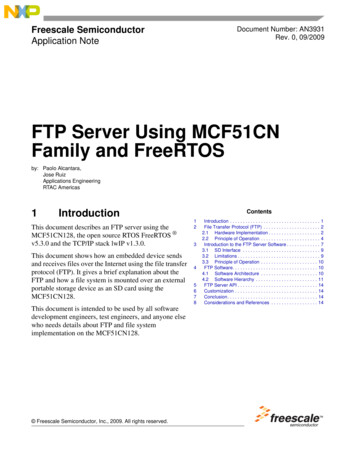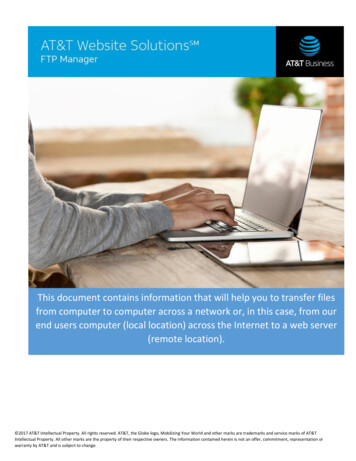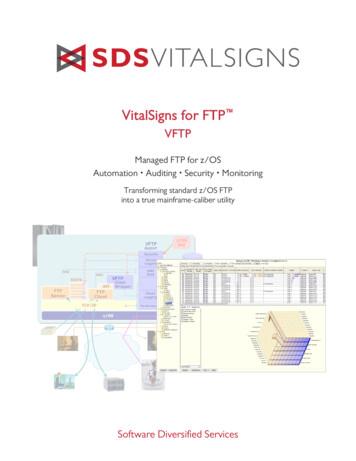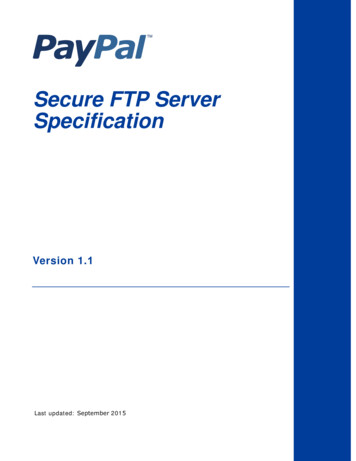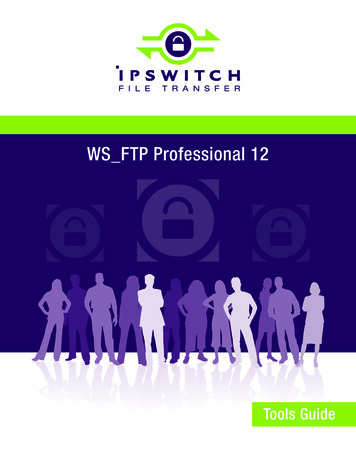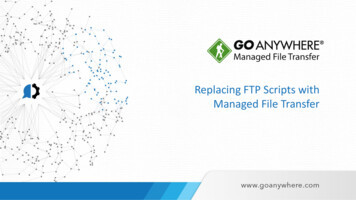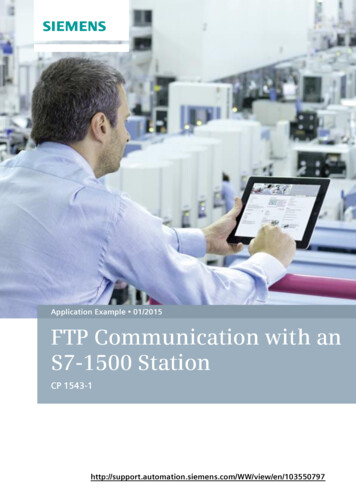
Transcription
Application Example 01/2015FTP Communication with anS7-1500 StationCP w/en/103550797
Warranty and LiabilityWarranty and LiabilityNoteThe Application Examples are not binding and do not claim to be complete withregard to configuration, equipment or any contingencies. The ApplicationExamples do not represent customer-specific solutions. They are only intendedto provide support for typical applications. You are responsible for the correctoperation of the described products. These Application Examples do not relieveyou of the responsibility of safely and professionally using, installing, operatingand servicing equipment. When using these Application Examples, yourecognize that we cannot be made liable for any damage/claims beyond theliability clause described. We reserve the right to make changes to theseApplication Examples at any time and without prior notice. If there are anydeviations between the recommendations provided in this Application Exampleand other Siemens publications – e.g. catalogs – the contents of the otherdocuments have priority.We do not accept any liability for the information contained in this document. Siemens AG 2015 All rights reservedAny claims against us – based on whatever legal reason – resulting from the use ofthe examples, information, programs, engineering and performance data etc.,described in this Application Example will be excluded. Such an exclusion will notapply in the case of mandatory liability, e.g. under the German Product Liability Act(“Produkthaftungsgesetz”), in case of intent, gross negligence, or injury of life, bodyor health, guarantee for the quality of a product, fraudulent concealment of adeficiency or breach of a condition which goes to the root of the contract(“wesentliche Vertragspflichten”). The compensation for damages due to a breachof a fundamental contractual obligation is, however, limited to the foreseeabledamage, typical for the type of contract, except in the event of intent or grossnegligence or injury to life, body or health. The above provisions do not imply achange in the burden of proof to your disadvantage.Any form of duplication or distribution of these Application Examples or excerptshereof is prohibited without the expressed consent of Siemens Industry Sector.SecurityinformationSiemens provides products and solutions with industrial security functions thatsupport the secure operation of plants, solutions, machines, equipment and/ornetworks. They are important components in a holistic industrial securityconcept. With this in mind, Siemens’ products and solutions undergo continuousdevelopment. Siemens recommends strongly that you regularly check forproduct updates.For the secure operation of Siemens products and solutions, it is necessary totake suitable preventive action (e.g. cell protection concept) and integrate eachcomponent into a holistic, state-of-the-art industrial security concept. Third-partyproducts that may be in use should also be considered. For more informationabout industrial security, visit http://www.siemens.com/industrialsecurity.To stay informed about product updates as they occur, sign up for a productspecific newsletter. For more information, visithttp://support.automation.siemens.com.FTP 1500Entry ID: 103550797,V1.0,01/20152
Table of ContentsTable of ContentsWarranty and Liability . 21Task . 42Solution. 52.12.22.2.12.2.22.32.3.12.3.23Basics . 134Function Mechanisms . 154.14.24.34.3.15 Siemens AG 2015 All rights reservedOverview. 5Description of the core functionality . 7Scenario 1: CP 1543-1 as FTP server . 7Scenario 2: CP 1543-1 as FTP client . 9Hardware and software components . 12Validity . 12Components used . 12Configuration and Settings. 255.15.25.35.46Procedure when using alternative hardware . 25General connection settings . 26General procedure for commissioning the FTP serverfunctionality . 28General procedure for commissioning the FTP clientfunctionality . 31Installation and Commissioning . 326.16.26.36.3.16.3.26.3.36.3.47General overview . 15Description of scenario 1: CP 1543-1 as FTP server . 20Description of scenario 2: CP 1543-1 as FTP client . 21Details on FB “FTP 1500 Communication” . 21Hardware installation . 32Software installation (download) . 33Commissioning . 34FileZilla FTP server . 34FileZilla FTP client . 36Controller S7-1500 and HMI. 36Adapting the S7 program . 39Operation of the Application . 407.17.27.37.3.17.3.2Menu navigation when using the HMI . 40Scenario 1: CP 1543-1 as FTP server . 41Scenario 2: CP 1543-1 as FTP client . 44Operating the data transfer with HMI . 44Operation without HMI . 458Related Literature . 469History. 46FTP 1500Entry ID: 103550797,V1.0,01/20153
1 Task2.1 Overview1TaskIntroductionIn many projects and on many systems it is necessary to exchange process databetween controller and servers/PCs, in order to enable working with the thereproduced data outside of the control level as well.This is made possible by standardized protocols.An FTP protocol is a protocol which has established itself as a standard for dataexchange due to its versatility (independent of connection type and operatingsystem) and protection mechanism (assignment of access rights and explicit datapath enable).Overview of the automation taskThe figure below provides an overview of the automation task.Figure 1-1FTP clientFTPCommunicationFTP server Siemens AG 2015 All rights reservedPG / PCS7 stationProcessing/sending/requestingdataS7 stationSuppliesdataPG / PCDescription of the automation taskAn S7-1500 controller shall exchange data with a PC via FTP. CP 1543-1 ispredestined for this since it can take on the function of FTP client as well as FTPserver.The following scenarios shall be realized here: The CP 1543-1 requests data from an FTP server as FTP client(active/passive) and stores it in a suitable data structure or sends a suitabledata structure to an FTP server, where it is stored as a file. The CP 1543-1 provides its file system to an FTP client as an FTP server.As an FTP server, the CP only provides access while as an FTP client it needs toactively act via various FTP commands. In order to spare the SIMATIC userprogramming the required steps and commands, a function block for the S7-1500will be developed which contains all the steps necessary for FTP data transfer.FTP 1500Entry ID: 103550797,V1.0,01/20154
2 Solution2.1 Overview2Solution2.1OverviewDisplayThe figure below shows a schematic overview of the most important components ofthe solution:Figure 2-1FTP serverFTP client Siemens AG 2015 All rights reserved Send data toS7 station Request process datafrom S7 stationS7-1500 withCP 1543-1 asFTP client / serverHMI panelOn site operation Send process datato server Request files fromserverPROFINET / IEA small network will be set up for demonstrating the data exchange between anautomation plant and a local PC.The automation part is represented by a S7-1500 CPU and a CP 1543-1.FTP client and FTP server software is installed on the local PG/PC.If the CP is used as FTP client, the FTP data exchange is handled via FTP functionblock (“FTP 1500 Communication”).The operation of the FTP data exchange is either handled via the tag table or viaHMI (optional).NoteThe FTP function block (“FTP 1500 Communication”) is delivered with theexample project of this application.FTP 1500Entry ID: 103550797,V1.0,01/20155
2 Solution2.1 OverviewAdvantagesThe solution presented here offers you the following advantages: Simple and easy to understand FTP communication with an S7-1500 controllervia the “FTP 1500 Communication” block. Expandability of the example application by some process data and differentFTP servers and clients.DelimitationThis application does not contain a description of: FTP servers (PC application) FTP clients (PC application) HMI panels PLCs (especially S7-1500) SCL programmingBasic knowledge of these topics is assumed.Required knowledge Siemens AG 2015 All rights reservedBasic knowledge of STEP 7 V13, WinCC V13, FBD, SCL, Ethernet and TCP/IP isassumed.FTP 1500Entry ID: 103550797,V1.0,01/20156
2 Solution2.2 Description of the core functionality2.2Description of the core functionalityThe example project for this application contains two scenarios2.2.1 Scenario 1: the CP 1543-1 is an FTP server. An FTP client can write files toand read files from the file system. Scenario 2: CP 1543-1 is the FTP client and can access an FTP server withthe following FTP commands: NOOP, STORE, RETRIEVE, DELETE, APPENDand RETR PART.Scenario 1: CP 1543-1 as FTP serverFlow chart for scenario 1 Siemens AG 2015 All rights reservedFigure 2-25Wait for connectionof a client.1Client connectswith CP2Connected?NoYesTrigger datatransfer manuallyon client3Data sent/received?NoError(failed transfer)Terminate programsequenceData transfer successful(successful transfer)Terminate program sequenceYesClient terminatesthe connection4Properlydisconnected?NoYesNoteFor CP 1543-1, 16 parallel connections to the FTP server are possible.FTP 1500Entry ID: 103550797,V1.0,01/20157
2 Solution2.2 Description of the core functionalityTable 2-1 Siemens AG 2015 All rights reservedActionNote1.FTP client connects withCP 1543-1 (action on the PG / PC).The connection data is entered via theuser interface of the FTP client (IPaddress, User name, Password)2.Checking the connection status:OK: triggering the selected commandNOK: program termination; the error isdisplayed in the status display of theFTP client software.When NOK, the FTP client registers afailed transfer in its status display.3.Checking the data exchange:OK: triggering the disconnectionprocessNOK: program termination; the error isdisplayed in the status display of theFTP client software.When NOK, the FTP client registers afailed transfer in its status display.4.Checking the disconnection:OK: terminate program sequence.NOK: program termination; the error isdisplayed in the status display of theFTP client software.When NOK, the FTP client registers afailed transfer in its status display.5.Waiting for new trigger by the userCP 1543-1 waits for renewed connectionof an FTP client.HMI visualizationThe operation of scenario 1 can be controlled via the HMI. The graphic belowshows one of the visualization user interfaces.Figure 2-32341FTP 1500Entry ID: 103550797,V1.0,01/20158
2 Solution2.2 Description of the core functionalityTable 2-2No.Note1.Display of contents and status of the variousassigned memory areas in the FTP server (inthis case: DB1, DB2, DB3).2.Locking the various assigned memory areas inthe FTP server (here: DB1, DB2, DB3).It is now no longer possible to overwrite thedata in the DBs. An error message is outputon the FTP client, if data transfer is startednevertheless.3.Unlocking the various assigned memory areasin the FTP server (here: DB1, DB2, DB3).It is now possible again to overwrite the datain the DBs.4.Confirming the received data. You can“confirm” individually, or all at once.In reality, this option would in most cases runautomatically by the user program after thedata has been received and processed.Note2.2.2 Siemens AG 2015 All rights reservedActionThe application needs not be controlled via the HMI.Scenario 2: CP 1543-1 as FTP clientFlow chart for scenario 2Figure 2-45Wait for new trigger1StartConnect to FTPserver2Connected?NoYesData exchangetriggeredautomatically3Data sent/received?YesDisconnect fromFTP serverNoERROR:Terminate program sequenceOutput specific status(depending on error)DONE:Terminate program sequenceOutput specific status(OK; 0000)NoProperlydisconnected?4YesFTP 1500Entry ID: 103550797,V1.0,01/20159
2 Solution2.2 Description of the core functionalityTable 2-3 Siemens AG 2015 All rights reservedActionNote1.As soon as a job trigger was initiated bysetting the “REQ” input, the CP 1543-1connects with the FTP server.The connection data are entered inFTP PARAM (IP address, User name,Password, file name .)2.Checking the connection status:OK: triggering the selected command.NOK: terminates program sequenceand outputs the error-specific statusAn “ERROR” occurs during NOK. Theerror status is given in “STATUS”.3.Checking the data exchange:OK: triggering the disconnectionprocess.NOK: terminates the programsequence and outputs the error-specificstatusAn “ERROR” occurs during NOK. Theerror status is given in “STATUS”.4.Checking the disconnection:OK: terminates the program sequenceand outputs the status (0x0000): no jobbeing processed. / Job completedwithout error.NOK: terminates the programsequence and outputs the error-specificstatusAn “ERROR” occurs during NOK. Theerror status is given in “STATUS”.5.Waiting for new trigger by the userAlso possible at “ERROR”.HMI visualizationScenario 2 can be controlled via the HMI. The graphic below shows one of thevisualization user interfaces.Figure 2-551234FTP 1500Entry ID: 103550797,V1.0,01/2015610
2 Solution2.2 Description of the core functionalityTable 2-4 Siemens AG 2015 All rights reservedNo.NoteActionRemarks1.Entering user data and IP address ofthe server.This access data is configured in theHW configuration.2.Selecting the FTP command from adrop-down list.Possible commands:STORE, APPEND, DELETE,RETRIEVE, RETRIEVE PART.3.Entering the file name of the file towhich the send data is sent or fromwhich data is received.Generally, each file format is possible.The display of the HMI, however, onlyreads “txt” files.4.Confirming new received data.Confirming only necessary as soon asnew data was received. Data can onlybe received again after confirming.5.Display of send and receive data.6.Display of Status and Start button forstarting the communication.DONE: “True”, if job completedsuccessfully.BUSY: “True”, while job running.ERROR: “True”, when an error hasoccurred.STATUS:The application needs not be controlled via the HMI, but can also be controlledvia tag table “Control-VAR”.FTP 1500Entry ID: 103550797,V1.0,01/201511
2 Solution2.3 Hardware and software components2.3Hardware and software components2.3.1ValidityThis application is valid for2.3.2 STEP 7 V13 or higher WinCC Professional as of V13 S7-1500 Any FTP servers (PC application) Any FTP clients (PC application)Components usedThe application was created with the following components:Hardware componentsTable 2-5 Siemens AG 2015 All rights reservedComponentQty.Article numberNoteSIMATIC S7-1500CPU 1511-1PN16ES7511-1 AK00-0AB0Alternatively, any otherSIMATIC S7-1500 compatiblewith the CP can be used withPN interface.PM 70W 120/130VAC16EP1332-4BA00Alternatively, any othervoltage supply can also beused.CP 1543-116GK7 543-1 AX00-0EX0Required.Software componentsTable 2-6ComponentQty.Article numberNoteSTEP 7 PROFESSIONALV1316ES7822-1.03-.Or higher.WinCC PROFESSIONALV1316AV210.-.3-0Or higher, only when usingHMI.FileZilla FTP serversoftware1Freeware (GPL)Or other FTP server softwareFileZilla FTP clientsoftware1Freeware (GPL)Or other FTP client softwareSample files and projectsThe following list includes all files and projects that are used in this example.Table 2-7Component103550797 FTP 1500 V10.zip103550797 FTP 1500 DOKU v10 e.pdfFTP 1500Entry ID: 103550797,V1.0,01/2015NoteThis zip file contains the STEP 7 V13project.This document.12
3 Basics2.3 Hardware and software components3BasicsFTP generalFTP was developed to exchange files between an FTP client and an FTP server.Furthermore, it is designed for managing directories via remote access. In theworld of automation technology, this is a useful protocol for making the dataexchange as simple as possible.There are two modes for FTP communication: active FTP passive FTPFTP active Siemens AG 2015 All rights reservedIn this mode, the FTP client opens a random port ( 1023) and sends it and its ownIP address to the FTP server using a special command (PORT or EPRT). As astandard, it is sent to port 21 of the FTP server (it must be open or forwarded in thefirewall of the server, otherwise no communication will be established). When datatransfer is requested, the FTP server then initiates a data connection to thetransferred IP address and FTP server port 20.The active mode is used when the FTP server is located behind a firewall, sincethe data connection is initiated from the FTP server outwards, hence, not blockedby the firewall; i.e. the FTP server acts actively.The following graphic illustrates the active FTP communication:Figure 3-1ActiveFTP communicationFTP clientPortXFTP serverPortXControl port21Data port20Expected control connectionExpected data connectionCloses data connectionafter data transferFTP 1500Entry ID: 103550797,V1.0,01/201513
3 Basics2.3 Hardware and software componentsFTP passiveIn this mode, the FTP client sends a PASV or EPASV command to port 21 of theFTP server. The FTP server then opens a random port and transmits this portnumber to the FTP client together with its IP address. For the data transfer, theFTP client now initiates a TCP connection to the IP address sent by the FTP serverand the port.The passive mode is used when the FTP client is located behind a firewall. Thestateful packet inspection normally always allows outgoing data packets in thefirewall. The FTP server hence reacts passively.Figure 3-2PassiveFTP communicationFTP clientPortXFTP serverPortXControl port21Data port20 Siemens AG 2015 All rights reservedExpected control connectionExpected data connectionCloses data connectionafter data transferFTP 1500Entry ID: 103550797,V1.0,01/201514
4 Function Mechanisms4.1 General overview4Function Mechanisms4.1General overviewProgram structureFigure 4-1FTP CMDClientRecieveDataMAIN[OB 1]FTPParamHMI Convert Siemens AG 2015 All rights reservedServer MemoryDB 1/2/3SystemblocksUser programScenario 1FTP 1500communicationScenario 2ClientSend DataDatablocksThe program structure is divided into three parts: the user program, the systemblocks and the data blocks.In the user program, all function blocks are called cyclically by OB 1.The system blocks show the library blocks which are used.The data blocks are used as data storage for server and client. In addition, the datarecorded by the HMI is also saved.NoteWhen changing the symbolic names of the blocks, you need to recompile theentire program.When changing the number of “Server DBs” or “Client DBs”, you need to adjustFB “HMI Convert” accordingly.FTP 1500Entry ID: 103550797,V1.0,01/201515
4 Function Mechanisms4.1 General overviewBlock listThe table below gives you an overview of the program blocks of this application.Table 4-1 Siemens AG 2015 All rights reservedElementSymbolic nameProgramminglanguageDescriptionOB1MainFBDCyclic OB:Calling the blocks for bothscenarios.FB1FTP 1500 CommunicationSCLScenario 2:Processing the inputs of user, FTPmanager for sending and receivingdata to and from the FTP server.FB2HMI ConvertSCLOptional (only necessary if HMIshall be used):Scenario 1&2:Locking/unlocking/confirming datain the server memory DBs.Transforming the arrays into text fordisplay on the HMI.DB1Server MemoryDB 1Scenario 1:memory area 1.DB2Server MemoryDB 2Scenario 1:memory area 2.DB3Server MemoryDB 3Scenario 1:memory area 3.DB5Client Send DataScenario 2:Process data to be sent to the FTPserver.DB6FTP ParamScenario 1&2:Contains the parameters necessaryfor operation.DB7Client Retrieve DataScenario 2:Process data, called by the FTPserver.DB10FTP 1500Communication DBScenario 2:Instance DB for“FTP 1500 Communication”.DB11HMI Convert DBScenario 1&2:Instance DB for “HMI Convert”.“Main”OB 1 calls the following blocks:-FB1: “FTP 1500 Communication” is the FTP manager for scenario 2.-FB2: “HMI Convert” is the interface between HMI and CPU. Enables aconvenient operation of the application example via HMI. Amongst otherthings, the block transforms the receive data into a string (which can be readon the HMI).In “Main”, “FTP Param” is furthermore interconnected to the inputs of“FTP 1500 Communication” in order to guarantee operability.FTP 1500Entry ID: 103550797,V1.0,01/201516
4 Function Mechanisms4.1 General overview“HMI Convert”Function block “HMI Convert” transforms the data of the used DBs, stored in abyte array, into strings. The data can hence be displayed as text on the userinterface.In addition, it enables the user to confirm the data he received from the FTP client.Furthermore, memory areas of the FTP server can be locked and unlocked fromhere.The block has the following parameter interfaces:Figure 4-2OutputInput Siemens AG 2015 All rights reservedThe block has the following inputs:Table e, which DB is unlocked (1, 2, 3) or all (4).LOCKDBIntSelectable, which DB is locked (1, 2, 3) or all (4).CONFIRMDATAIntConfirming the data of individual DBs (1, 2, 3) or allDBs (4).The data of the DBs can also be locked/unlocked/confirmed via program(parameter LOCK and NEW in UDT “FILE DB HEADER”)The block has the following outputs:Table ng from byte array of the first server DB.SERVERMEM2StringString from byte array of the second server DB.SERVERMEM3StringString from byte array of the third server DB.SENDDATAMEMStringString from byte array of the send DB (client).RETRDATAMEMStringString from byte array of the receive DB (client).The outputs of this FB are required for displaying the data of the DBs on the HMI.FTP 1500Entry ID: 103550797,V1.0,01/201517
4 Function Mechanisms4.1 General overviewFTP PARAMData block “FTP PARAM” contains the parameters mandatory for thecommunication with the CP 1543-1 as FTP client.The following parameters must be supplied.Table 4-4NameFILENAMEDescriptionFTP FILENAMEInterfaceIdHW ANYHW identifier of the CP1543-1 in HWConfig.IDCONN OUCAn ID which must be identicalthroughout the entire FTPcommunication.LenFilenameUIntSpecifies the maximum length of theselectable file names.FilenameArray[0.3] of StringThe device name is entered here.Folder structures can also be createdhere.CONNECTIONIPV4 Siemens AG 2015 All rights reservedData typeFTP CONNECT IPV4InterfaceIdHW ANYSee FILENAME.IDCONN OUCSee FILENAME.UserNameString[32]Entering a valid user name.PasswordString[32]Entering a valid password.FTPserverIPaddrIP V4Entering the IP address of the FTPserver.FILENAME PARTFTP FILENAMEPARTInterfaceIdHW ANYSee FILENAME.IDCONN OUCSee FILENAME.OffsetDWordSpecifies from which byte on the filemust be read.LengthDWordSpecifies how many bytes are readfrom the “Offset” on.LenFilenameUIntSee FILENAME.FilenameArray[0.3] of StringSee FILENAME.DBNrSendDataIntSpecifies which DB shall be used forthe send data.DBNrRetrieveDataIntSpecifies which DB shall be used forthe called file.ComTypeIntSpecifies which FTP command shall beexecuted:- 0 no action- 1 send- 2 retrieve- 3 delete- 4 append- 5 retrieve part.FTP 1500Entry ID: 103550797,V1.0,01/201518
4 Function Mechanisms4.1 General overviewNote“InterfaceId” and “ID” must be identical for “FILENAME”, “CONNECTIONIPV4”and “FILENAME PART”.Instead of two separate data blocks for sending and receiving, you can also useone for both and reference it accordingly at the respective locations.UDT “FILE DB HEADER”UDT “FILE DB HEADER” enables using the data block as transferrable file duringa data transfer. Any DB sent/called with FTP must start with “FILE DB HEADER”.The following table shows the parameters of UDT “FILE DB HEADER”.Table 4-5 Siemens AG 2015 All rights reservedNameData typeRemarksBit04-Bit15BoolReserved bits.EXISTBoolSpecifies whether the content of the data blockcontains valid data.LOCKEDBoolSpecifies whether the data block is currently locked.The content of the DB is locked if the bit has beenset.NEWBoolSpecifies that the data block has received newdata. As long as the NEW bit is set, no data can bewritten over the current data of the DB. These musteither be confirmed manually or by the userprogram.WRITEACCESSBoolFor “TRUE”, the FTP server has write access.For “FALSE”, FB “FTP CMD” has write access.ACT LENGTHDIntOutputs the current length of the data stored in thedata block in bytes.MAX LENGTHDintOutputs the maximum length of the data allowed tobe stored in the data block in bytes.FTP REPLY CODEIntOutputs the three-digit FTP “Reply Code”.DATE TIMEDATEAND TIMEThe current date is renewed at each writeoperation. Only valid if EXIST 1.FTP 1500Entry ID: 103550797,V1.0,01/201519
4 Function Mechanisms4.2 Description of scenario 1: CP 1543-1 as FTP server4.2Description of scenario 1: CP 1543-1 as FTP serverThe figure below shows the program sequence for scenario 1:Figure 4-3Create file withpreviouslydefined nameEnter connection dataFill the filewith data tobe sentYesNoEnter on FTP clientOnly required if to besent to PLCCheck / allowconnection to FTPserver- User managementDisconnect? Siemens AG 2015 All rights reservedData transferTrigger on FTP clientProcessing the data /desired operation onserver(LOCK;UNLOCK;CONFIRM)In scenario 1, the controller works as an FTP server. Data connections betweenFTP client and FTP server are established to be able to transfer data. Data caneither be transferred here from FTP server to FTP client or from FTP client to FTPserver. For the latter one, memory areas must be created in the controller wherethe data of the FTP client is stored.The data is sent from a PC (FTP client) to the CP 1543-1 (FTP server). Thereceived data is stored in a DB (DB1/DB2/DB3). In this application example, thedata can be locked (LOCKED 1) and unlocked (LOCKED 0) in the DB after whichthey cannot be overwritten anymore by the FTP client. The FTP server must alsoconfirm that the data from the FTP client was received (NEW 0). These functionscan be controlled via the HMI and the respective “HMI Convert” block oralternatively via the tag table.A large part of this scenario is controlled via the FTP client (connect, data transfer,disconnect). The other functions can be controlled directly at the respective DBs orvia the HMI.FTP 1500Entry ID: 103550797,V1.0,01/201520
4 Function Mechanisms4.3 Description of scenario 2: CP 1543-1 as FTP client4.3Description of scenario 2: CP 1543-1 as FTP clientFigure 4-4EnterconnectiondataEnter filenameSelectoperation Siemens AG 2015 All rights reservedStartEstablishconnection to FTPserverFB: FTP 1500 CommunicationStart data transferFB: FTP 1500 CommunicationTerminateconnection to FTPserverFB: FTP 1500 CommunicationOutputstatus andstateIn scenario 2, the communication processor is used as FTP client. FTPconnections are also set up here. All commands provided by function block“FTP CMD” can be executed (further information in the TIA Portal help “F1”). TheFTP client accesses a root folder to execute the commands.The produced process data can be transferred to an FTP server and stored in theroot directory of the FTP server under the given file name.The data is then located on the FTP server in the form of files. The data type of thisfile can be selected at will by the user according to file names. Principally, any datatype can be written to or read.Data can also be requested from the root directory and stored in the selected DBon the controller.Note4.3.1If a file with the entered file name already exists in the root directory, this file willbe overwritten.Details on FB “FTP 1500 Communication”GeneralFTP function block “FTP 1500 Communication” comprises the necessary steps forFTP communication in one block. Contains a step chain from establis
Scenario 1: the CP 1543-1 is an FTP server. An FTP client can write files to and read files from the file system. Scenario 2: CP 1543-1 is the FTP client and can access an FTP server with the following FTP commands: NOOP, STORE, RETRIEVE, DELETE, APPEND and RETR_PART. 2.2.1 Scenario 1: CP 1543-1 as FTP server Flow chart for scenario 1
